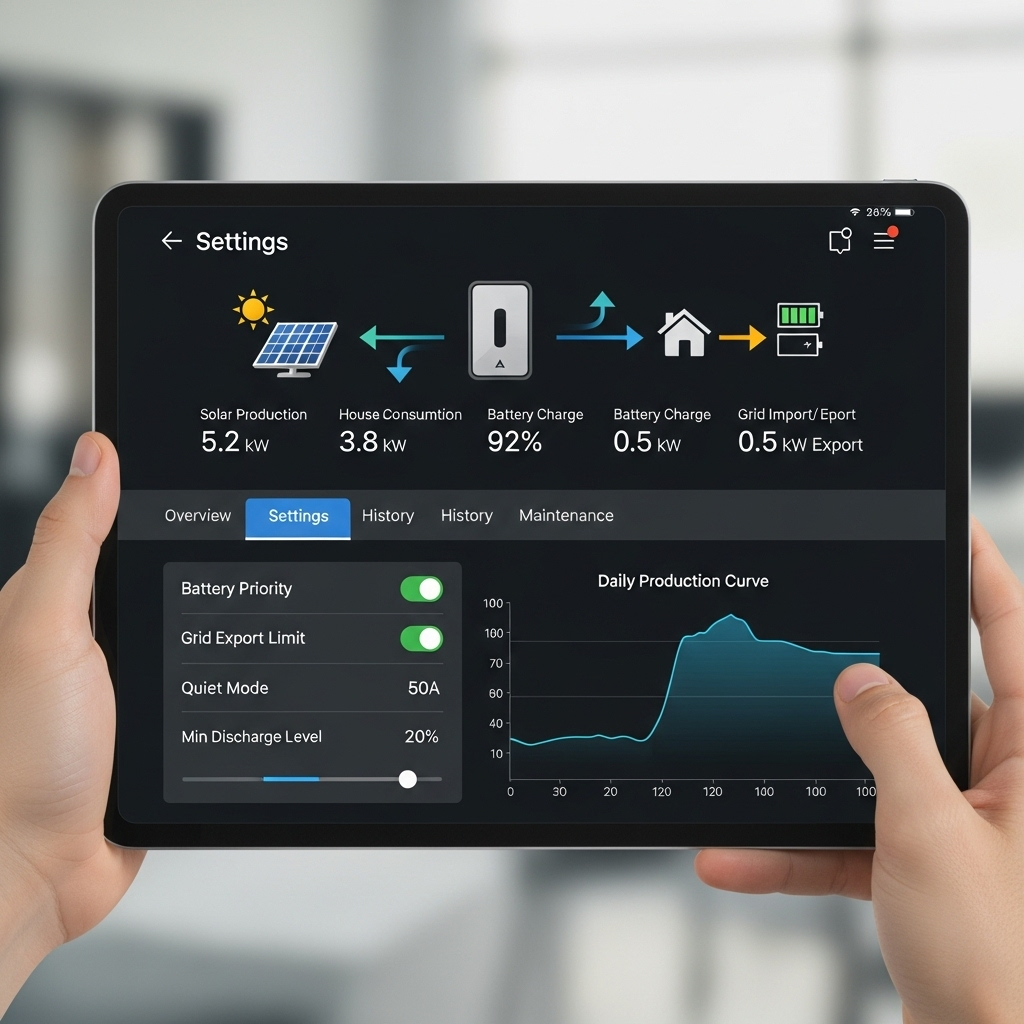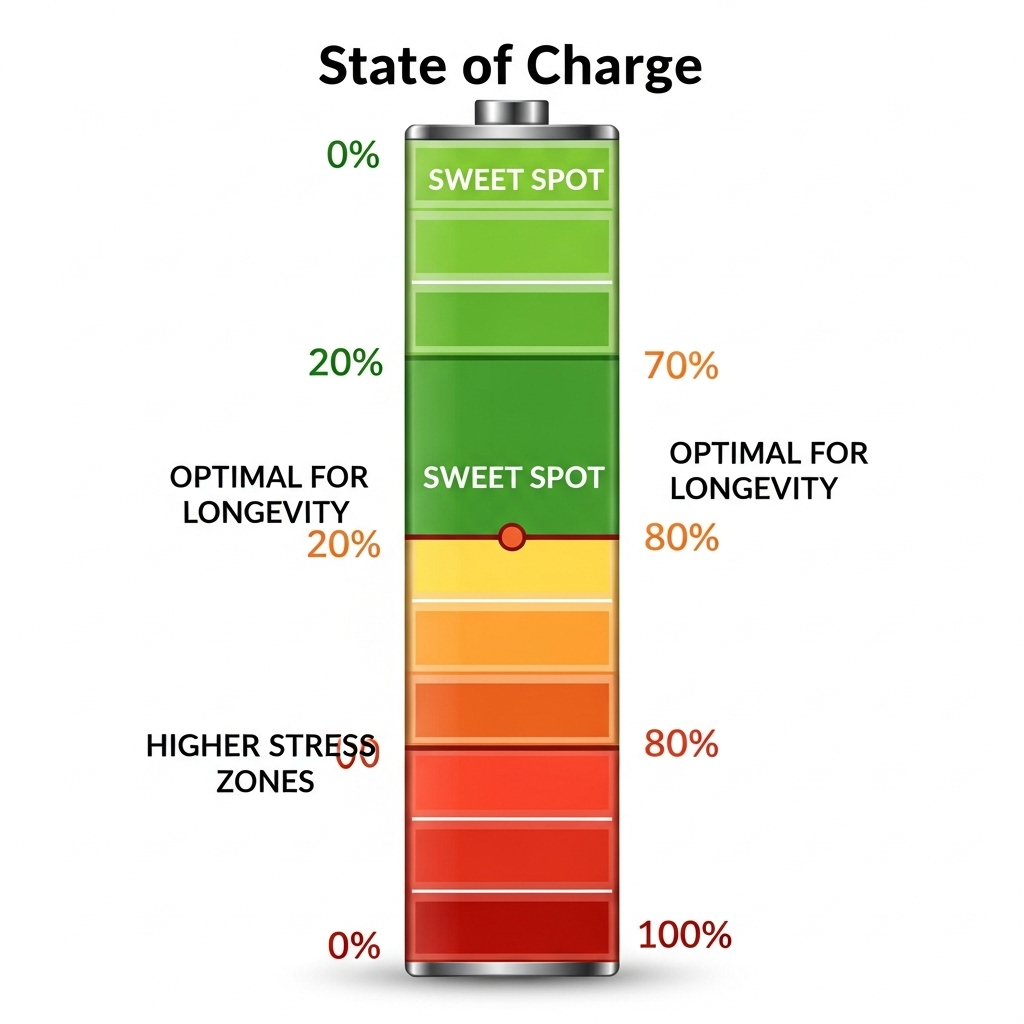Your solar inverter is the command center of your energy storage system. While its main job is converting DC power to AC, its software holds powerful tools for managing your battery's health. One of the most effective ways to enhance battery longevity is by using the inverter's settings to enforce a daily State of Charge (SOC) window. This review focuses on the specific settings and configurations within your inverter that make this possible, turning a complex concept into a practical action.
Understanding the Core Inverter Settings for SOC Management
Properly configuring your inverter is not just about initial setup; it is an ongoing process of optimization. The right settings protect your battery investment by preventing the stress that shortens its life. These controls are your primary interface for implementing a smart battery management strategy.
The 'Brain' of Your System: Where to Find SOC Controls
Most modern inverters house these critical settings in a dedicated menu, often labeled 'Battery Settings,' 'Energy Management,' or 'Storage Mode.' You can typically access this control panel in one of three ways:
- On-Unit Display: Many inverters feature a small LCD screen and buttons for direct configuration.
- Web Interface: By connecting a computer to the same network as your inverter, you can access a detailed web-based dashboard by typing its IP address into your browser.
- Mobile Application: The most convenient method for many users, a dedicated smartphone app offers remote monitoring and adjustment capabilities.
Key Parameters You Will Encounter
When you navigate to the battery menu, you will find several key parameters. While the terminology may vary slightly between brands, the functions are universal.
- Maximum Charge SOC (Upper Limit): This setting tells the inverter to stop charging the battery once it reaches a certain percentage. For LiFePO4 batteries, setting this to 90% or 95% instead of 100% can reduce cell stress and significantly extend cycle life.
- Minimum Discharge SOC (Lower Limit/Reserve): This parameter prevents the battery from draining completely. It instructs the inverter to stop drawing power from the battery and switch to another source (like the grid) when the SOC hits this floor. A common lower limit is 20%.
- Grid Charge Settings: Some inverters allow you to charge your battery from the grid. This feature can be used to ensure your battery reaches a minimum state of charge during long periods of low solar production, working in tandem with your SOC limits.
A Practical Walkthrough of Inverter Configuration Optimization
Let's move from theory to practice. Optimizing your inverter settings involves balancing daily energy needs with long-term battery health. Here are a few common strategies and the steps to implement them.
Setting a Conservative SOC Window (e.g., 20-80%)
This approach prioritizes battery longevity above all else. By operating in a narrow SOC window, you minimize stress on the battery chemistry. To do this, navigate to your inverter's battery settings and set the 'Maximum Charge SOC' to 80% and the 'Minimum Discharge SOC' to 20%. The trade-off is a reduction in daily usable capacity, but the potential gain in cycle life can be substantial, making it ideal for systems where maximizing lifespan is the primary goal.
Configuring for Balanced Performance (e.g., 10-90%)
A more common strategy for residential systems is to balance daily usability with battery care. A 10-90% SOC window provides 80% of the battery's nominal capacity for daily use while still avoiding the extremes of full charge and deep discharge. This configuration is an excellent middle ground, offering ample power for daily needs and still promoting a long and healthy service life for your battery.
Advanced Settings: Time-of-Use and Priority Logic
Sophisticated inverters offer advanced modes that interact with your basic SOC limits. For example, a 'Time-of-Use (ToU) Mode' can be programmed to discharge the battery during expensive peak grid hours and recharge with cheap off-peak grid power or solar. In this scenario, the inverter's logic will work within the SOC window you have defined, optimizing for cost savings without compromising battery health. These features demonstrate how modern inverters are becoming smarter energy management hubs.
How Inverters Enforce SOC Windows in Real-World Scenarios
Setting the limits is the first step. Understanding how the inverter actively enforces them during daily operations clarifies their importance. The inverter acts as a vigilant gatekeeper for your battery.
During a Sunny Day: Solar Charging
On a clear day, your solar panels may produce more power than your home needs. The inverter intelligently directs this excess energy to charge your battery. Once the battery's voltage corresponds to the 'Maximum Charge SOC' you have set, the inverter's charge controller stops the flow of energy. Any further excess solar generation is then either curtailed or exported to the grid. This function is a practical application of the advanced controls mentioned in IEA reports. According to the Next Generation Wind and Solar Power study, modern inverters have the capacity to reduce generation via automatic instructions, which is exactly what happens when an SOC limit is enforced.
During the Night or Low Sun: Battery Discharging
When the sun goes down, your system switches to battery power. As your home consumes energy, the SOC level drops. Once it reaches the 'Minimum Discharge SOC' limit, the inverter automatically disconnects the battery from the load and switches to pulling power from the grid. This action is crucial for preventing deep discharge, a major cause of battery degradation. This micro-level management contributes to overall system stability, a principle highlighted by IRENA. The Grid Codes for Renewable Powered Systems report notes that inverter-based resources are integral to system operations, and managing discharge is a core function.
Verifying and Monitoring Your SOC Settings
After configuring your inverter, it is important to verify that the settings are working as intended. Regular monitoring ensures your system continues to operate optimally.
Using the Inverter's Monitoring Portal
The monitoring portal, whether on a web browser or mobile app, is your best tool for verification. Look for the battery SOC graph over a 24-hour period. You should clearly see the charge level flatten out at your set maximum and the discharge level stop at your set minimum. This visual confirmation proves the inverter is successfully enforcing your desired SOC window.
The Importance of Regular Checks and Adjustments
Your energy needs can change, especially with the seasons. It is wise to review your SOC settings periodically. You might opt for a wider window in the summer when solar production is high and a narrower one in the winter to preserve the battery. For a deeper analysis of how these adjustments affect overall efficiency, the ultimate reference on solar storage performance offers valuable data that can inform your decisions.
What If the Inverter Ignores the Settings?
If you notice your battery is charging to 100% or dropping below your minimum limit, first check that the settings were saved correctly. Then, look for any available firmware updates for your inverter, as bugs are sometimes patched. Also, be aware that certain operating modes, such as a forced 'Backup Test,' might temporarily override your daily settings. As the IEA emphasizes in its manual, Getting Wind and Solar onto the Grid, 'Inappropriate equipment can have grave consequences for performance.' A reliable inverter that correctly follows commands is fundamental.
Final Thoughts on Inverter Configuration
Your inverter is far more than a simple power converter; it is an active asset management tool. By using its built-in settings to define and enforce a daily SOC window, you take direct control over the health and longevity of your battery. This simple act of configuration is one of the most impactful steps you can take to protect your energy storage investment and move closer to true energy independence. Smart management unlocks the full potential of your system.
Disclaimer: This article provides general information and recommendations. Always consult your inverter and battery manufacturer's documentation before making changes to your system settings. The information provided is not a substitute for professional electrical or financial advice.
Frequently Asked Questions (FAQ)
Will setting an SOC window void my battery warranty?
Generally, no. In fact, most manufacturers encourage it. Operating within a specified SOC range is considered best practice and often aligns with warranty conditions. Always check your specific battery warranty document for details on required operating parameters.
Can I change my SOC settings remotely?
Yes, most modern hybrid or off-grid inverters with internet connectivity offer a mobile app or web portal. This allows you to monitor and adjust your SOC windows and other settings from anywhere with an internet connection.
What happens if the grid goes down while my battery is at its minimum SOC limit?
This depends on your inverter's 'backup' or 'emergency power' settings. Many inverters have a separate, lower SOC reserve specifically for outages that overrides the daily minimum. For example, your daily minimum might be 20%, but your emergency reserve could be 10%. The system would stop discharging at 20% for daily use but would use the power between 20% and 10% during a grid failure.
Do all inverters have these settings?
Most modern hybrid and off-grid inverters designed for energy storage systems include these SOC management features. However, simpler grid-tie inverters without battery capability will not have them. When choosing an inverter for a storage system, verifying the presence and flexibility of these battery management settings is crucial.





Leave a comment
All comments are moderated before being published.
This site is protected by hCaptcha and the hCaptcha Privacy Policy and Terms of Service apply.